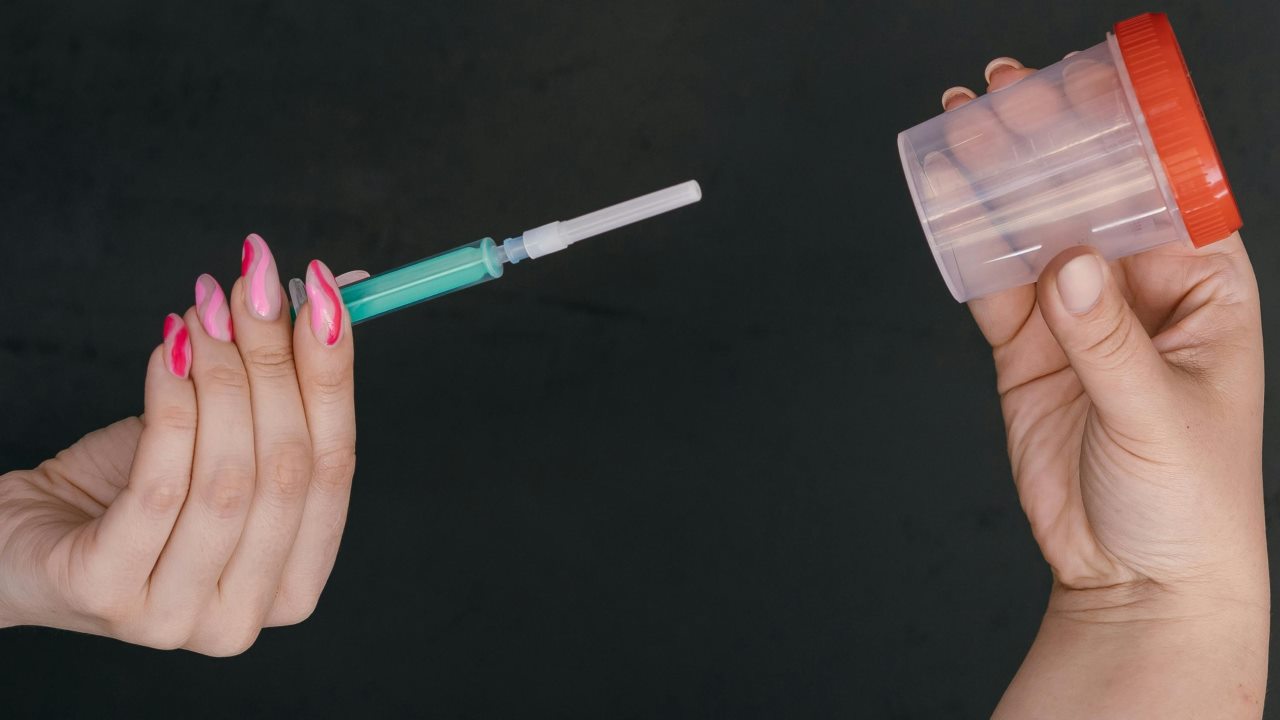Home insemination — also called self-insemination or DIY insemination — is a form of intracervical insemination (ICI). Fresh semen is collected in a clean cup and placed gently near the cervix with a needle-free syringe. Below you’ll find a clear step-by-step guide, realistic success ranges, practical timing tips, core safety points, and the essentials of Indian legal parenthood when using a known donor.
What home ICI involves
The donor ejaculates directly into a sterile container (specimen cup). Draw the sample slowly into a 5–10 mL syringe and release it gently into the vagina, aiming towards the cervical opening. Unlike clinic-based intrauterine insemination (IUI) or IVF, there is no laboratory sperm preparation at home. That keeps costs low and the process simple, but it places more weight on careful hygiene, accurate timing, and correct handling of fresh donor sperm.
For laboratory handling principles and why timing matters, see the WHO laboratory manual (6th ed., 2021). WHO Laboratory Manual 2021.
Pros and cons at a glance
Pros
- Private and relatively inexpensive at home
- Flexible timing around ovulation
- No invasive procedures
Cons
- Limited evidence for success rates in the home setting
- No clinical screening or lab preparation of the sample
- With a known donor, legal parenthood and responsibilities require planning under Indian law
Success rates: how to interpret them
Published data for at-home ICI are limited. In practice, ranges of roughly 5–15% per cycle are often quoted when timing and hygiene are strong. Clinic pathways differ because washed sperm and intrauterine placement (IUI) change the set-up; see the WHO manual above for handling basics.
Home insemination with a syringe: step-by-step
- Wash hands, clean the work surface, and set out sterile single-use supplies.
- Collect the semen directly into a sterile specimen cup.
- Let it liquefy at room temperature for 10–15 minutes.
- Draw up slowly into a 5–10 mL needle-free syringe, avoiding large air bubbles.
- Lie on your back with your hips slightly elevated. Insert the syringe tip about 1–2 inches and press the plunger slowly.
- Rest quietly for 20–30 minutes.
Handle the sample gently, avoid cold packs or heat, and aim to use it within about 30 minutes of collection — generally no later than ~60 minutes at room temperature. These windows align with good laboratory practice. WHO Laboratory Manual 2021.

Practical timing tips
- After a positive LH test, inseminate promptly. A second attempt about 12 hours later can help cover the ovulation window.
- Keep the sample at room temperature, do not shake, and avoid pushing the plunger hard.
- Use only lubricants labelled sperm-friendly and only if needed.
- Record cycle day, LH results, and insemination times to refine your plan.
Tracking the fertile window and repeating inseminations across 12–24 hours can help overlap sperm lifespan with ovulation.
How home ICI compares with IUI and IVF
| Method | Where | Lab prep | Typical chance per cycle | Good to know |
|---|---|---|---|---|
| Home insemination (ICI) | Home | No | ~5–15% | Low cost and private; results depend on timing, hygiene, and correct handling |
| IUI | Clinic | Yes | Often several cycles required | Medical oversight and quality standards in licensed facilities |
| IVF | Clinic | Yes | Higher per-cycle rates | More invasive and costly, but protocol-driven |
Safety and screening
If you are considering a private known-donor arrangement at home, ask for recent negative results for common STIs such as HIV, hepatitis B and C, syphilis, and chlamydia. If you use donor sperm through an ART clinic or bank in India, donors are screened and records maintained under the Assisted Reproductive Technology (Regulation) Act, 2021 and the ART (Regulation) Rules, 2022. ART Act, 2021; ART Rules, 2022.
Syringe basics: use a clean, needle-free 5–10 mL syringe; do not let semen sit in the syringe for long; avoid extreme temperatures; and never attempt to “wash sperm at home”. To locate registered clinics/banks, see India’s National ART & Surrogacy Portal. National ART & Surrogacy Portal.
Indian legal basics
In India, ART clinics and banks are regulated under the ART Act, 2021, with detailed operational requirements in the ART Rules, 2022 (screening, consent, record-keeping, and standards). These laws govern licensed services and donor gamete handling; parentage and guardianship are addressed under personal and family laws and may vary by state and case-law. For statutory text and summaries, see the Act/Rules and explanatory briefs. ART Act; ART Rules; PRS India: ART Act.
Home insemination with a known donor is lawful, but legal parenthood can be complex outside licensed clinics. Because consent forms, documentation and later disputes can affect outcomes, seek advice from an advocate experienced in donor conception and the ART framework in your state.
When to see a clinician
- Under 35: no pregnancy after 12 months of well-timed attempts
- 35 and over: no pregnancy after about 6 months
- Immediately if cycles are very irregular, there is significant pain or fever, or you live with conditions such as endometriosis, PCOS, or thyroid disease
These thresholds align with common referral practices; your clinician may individualise advice based on age, history and testing.
Conclusion
Home ICI can be a pragmatic route in India if you prepare sterile supplies, hit the fertile window, and handle the sample with care. Keep concise notes on timing, prioritise safety, and understand how the ART Act/Rules interact with your situation. With a tidy plan, realistic expectations, and consistent timing, you give yourself the best chance to turn a simple method into steady progress.

